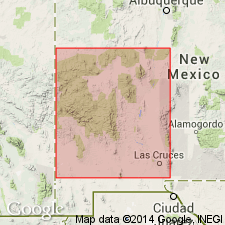
- Usage in publication:
-
- Sawmill Canyon Formation
- Modifications:
-
- Named
- Dominant lithology:
-
- Lava
- Tuff
- Sandstone
- AAPG geologic province:
-
- Orogrande basin
Summary:
Named for Sawmill Canyon. Type area located approximately 16 mi southeast of Magdalena along both sides Sawmill Canyon, secs 3, 4, 9, 10, 11, 14, 15, T5S, R3W, Socorro Co, NM, Orogrande basin. Called unit of Sixmile Canyon or Sixmile Canyon andesite in earlier reports; Sixmile Canyon andesite and unit of Sixmile Canyon abandoned in this report. Known in Magdalena Mountains. Divided into lower and upper members and tuff of Caronita Canyon (top). Includes the informal andesite of Landavaso Reservoir. Consists of andesitic lavas and interbedded andesitic mudflow and debris-flow deposits. To south andesite lavas interfinger with rhyolite lavas and conglomeratic sandstones, and the overlying thick, (up to 1,200 ft) multiple-flow, simple cooling unit of ash-flow tuff called tuff of Caronita Canyon which is also part of Sawmill Canyon. Forms the heterolithic fill of Sawmill Canyon cauldron. Also from local vent in Magdalena cauldron. Occurs between underlying La Jencia Tuff (new) and the overlying Lemitar Tuff. Assigned to Oligocene. K-Ar biotite date on bedded tuff in cauldron fill of 29.7 +/-1.1 m.y. and K-Ar biotite data on tuff of Caronita Canyon at top of fill of 30.2 +/-1.1 m.y.
Source: GNU records (USGS DDS-6; Denver GNULEX).
For more information, please contact Nancy Stamm, Geologic Names Committee Secretary.
Asterisk (*) indicates published by U.S. Geological Survey authors.
"No current usage" (†) implies that a name has been abandoned or has fallen into disuse. Former usage and, if known, replacement name given in parentheses ( ).
Slash (/) indicates name conflicts with nomenclatural guidelines (CSN, 1933; ACSN, 1961, 1970; NACSN, 1983, 2005, 2021). May be explained within brackets ([ ]).

